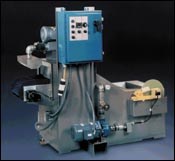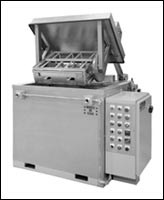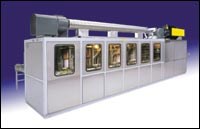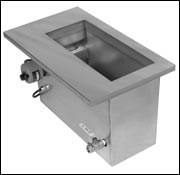Aqueous Cleaning Basics
Four factors affect the cleaning process: chemistry; temperature; energy; and time. The various combinations determine how clean your part will be. This article reviews the basics of each type of cleaning to help you determine what will work best for you...
#energy #basics
There always seems to be a mystery about parts cleaning applications. It's really quite simple to understand the basics, but there is much art and science beyond the surface. No article, especially one as short as this one, can make you a cleaning expert. But you can acquire enough understanding to approach an application intelligently and to guide you through the selection process.
There are four factors that affect the cleaning process: chemistry; temperature; mechanical energy; and time. The factors are generally synergistic. For example, in most cases adding a little heat (temperature) makes the cleaning solution (chemistry) more effective.
Featured Content
Consider a cleaning job that virtually all of us have done at least once, washing the dishes following a breakfast including eggs sunny-side up. Generally, there is some chemistry involved in the cleaning process, typically a detergent. Most of us know from experience that trying to clean dirty dishes without a detergent is difficult. We've all learned that the dishes are easier to clean with warm water. Usually it becomes a matter of how much heat your hands can stand. Even with a hot detergent solution it is necessary to scrub at least a little. The harder you scrub, the better the process works. The final factor is time. If you soak the dishes for a while, less scrubbing (mechanical energy) is required.
Chemistry
Most chemistries used in aqueous cleaning fit into one of three categories according to pH.
Neutral cleaners, the mildest of cleaners, are preferred when soils are light. Generally they are environmentally friendly. Depending on local codes and the composition of the soils that become part of the mix during use, spent cleaning solutions can sometimes be disposed of without further treatment.
Alkaline cleaners are the most commonly used cleaners for removing oils, greases and general soils. There are numerous chemistries available depending on the type and degree of contamination, the material to be cleaned, the type of cleaning equipment used and the subsequent use of the cleaned material.
Acidic cleaners are primarily used to remove tarnish and oxides and to brighten non-ferrous metals. Although some limited cleaning of organic soils (such as oils) is possible with some acidic chemistries, they are rarely used for general cleaning. It is not unusual, however, to use an acidic chemistry to brighten work previously processed with an alkaline cleaner and a rinse.
Temperature
Temperature has a significant effect on cleaning efficiency in most applications. Generally, the hotter the cleaning solution is, the faster cleaning occurs. One application that illustrates the effect of temperature is the removal of buffing compound. Most buffing compound formulations contain a significant portion of fats. Try to remove it at 120F and you are in for a long day. At about 150F cleaning becomes possible. At 180F cleaning is much easier. This is because the higher temperature softens, or pre-conditions, the contamination and allows the chemistry to work more efficiently.
There are other considerations concerning temperature. In a buffing compound removal application with brass parts, using 180F could cause the parts to tarnish as soon as they are removed from the cleaning solution. For this application there is more than one right answer. You can back off on the temperature and accept a longer cleaning cycle. Alternately, you can add another wash step (and rinse) using an acidic chemistry to remove the tarnish. This trade-off is typical of many cleaning applications where the advantages and disadvantages of various alternatives need to be balanced.
Mechanical Energy
Mechanical energy is sometimes described in more technical articles as "impingement" which refers to the application of mechanical force. Going back to the breakfast dishes, it is easy to visualize the more common forms of mechanical energy in relation to washing the dishes.
Mechanical scrubbing is the most common method of applying mechanical energy when washing the dishes by hand. The energy is usually delivered using a cloth or a sponge. In industrial cleaning, mechanical scrubbing is not common. Probably the greatest single reason for not using mechanical scrubbing in industrial applications is the maintenance required. For example, a simple rotating brush will wear and require constant adjustment to achieve consistent cleaning. The brush will also require periodic replacement.
A simple method of applying mechanical energy is to move the dish through the cleaning solution. Do it for a while, and the dish becomes clean. In industrial applications there are several types of equipment that operate on the principle of part agitation. The most common type of part agitation machine uses vertical agitation. The repeated up and down motion is effective in cleaning simple parts, such as parts without blind holes and/or deep grooves. Another type of part agitation machine uses a rotating basket, typically for small parts that tumble through the cleaning solution as the basket rotates. There is also part on part contact with a rotating basket that adds some mechanical scrubbing into the process.
Instead of moving the dish through the cleaning solution, the cleaning solution can be moved over the dish. Okay, so its not really a practical way of washing dishes by hand, but it illustrates the point. For industrial parts cleaning, there is practical equipment that uses liquid agitation. Methods for moving the liquid include impellers, eductors and air agitators. Liquid agitation can also be an effective way of cleaning simple parts without blind holes and deep grooves. It's not unusual to add liquid agitation to other types of equipment to increase effectiveness. For example, it is not unusual to combine a rotating basket with liquid agitation.
Most homes today have a dishwasher. It produces the mechanical energy for cleaning the dishes by spraying them with cleaning solution at some velocity. There are similar industrial spray-wash cleaning machines known as cabinet washers. They differ from the household variety in several ways. They are generally of higher capacity; the spray is usually of higher pressure (velocity); the spray nozzles are fixed; and the parts move on a turntable. Spray washers that move the parts in-line by conveyor are also common in industrial applications. The parts are moved through the wash, rinse and dry stages of the machine.
In reviewing the previous forms of applying mechanical energy to parts cleaning, comparing the process to washing dishes makes an obvious and intuitive connection. This is not so with ultrasonic cleaning. Therefore, an explanation of how ultrasonic cleaning works is necessary.
Ultrasonic cleaning depends on a phenomenon called "cavitation."
In ultrasonic cleaning, a sound wave is created in water in a manner similar to the way an audio speaker creates sound in air, by vibrating a diaphragm. As the sound wave passes through the water, alternating areas of high and low pressure are created. As the frequency of the sound becomes higher, the sound waves are closer together. When the frequency approaches the limit of human hearing and beyond, the alternating high- and low-pressure areas occur fast enough that cavitation can occur on a microscopic scale if the intensity (amplitude) of the sound wave is high enough.
The mechanical energy in ultrasonic cleaning occurs when the cavitation bubble implodes (collapses rapidly). Water rushes in to fill the space formerly occupied by the vapor bubble, at high velocity, although not exactly evenly. The result is "micro-jetting" that provides the mechanical energy for cleaning.
Cavitation occurs everywhere throughout the liquid, including deep grooves and blind holes, everywhere that the liquid can reach. Ultrasonic cleaning is effective on parts that are not cleanable by other methods.
A quick note about ultrasonic cleaning and chemistry is needed here. Not all cleaning chemistries are suitable for use in ultrasonic cleaning equipment. For good cavitation, the cleaning solution should have high surface tension, low vapor pressure and low viscosity. Consultation with your chemical supplier and/or equipment supplier is recommended.
Time
The fourth factor, time, is an important consideration in cleaning applications. For a given set of process conditions, longer exposure generally results in cleaner parts.
Going back to the breakfast dishes as an example, consider this scenario. You're running late one morning, and you just gather up the dishes with all of that runny egg residue and leave them in the sink. For cleaning them later that evening you might want to consider using a hammer and chisel. However, if you fill the sink with a warm detergent solution and come back in a couple of hours, you should have an easy job. In industry, production and economic requirements almost always influence the cleaning time that is available.
No discussion of aqueous cleaning is complete without mention of the importance of adequate rinsing. Depending on the material being cleaned, the chemistries used, and the cleanliness specifications, anything from a simple immersion or spray rinse to multiple rinses, including an ultrasonic rinse, may be required. Rinsing can be especially important with parts made from more than one metal. Chemical residue between the different metals can act like a battery and promote long-term corrosion.
Before beginning to develop a cleaning process, it's best that you are able to answer an often-overlooked question: How clean is clean? The answer can vary widely. For example, a machined aluminum bracket for a farm tractor accessory may need to be only clean enough for the assembler to handle and attach it without making a mess. On the other hand, an aluminum valve body for an ABS brake system may need to be 100% free of any particles greater than 10 microns.
The objective of this article is to provide a general understanding of aqueous cleaning and the factors that contribute to a successful application. Hopefully it has been at least partially successful. There is much more art and science involved that can and has filled complete books on the subject. Even those of us who are involved daily never stop learning.
RELATED CONTENT
-
Pretreatments: The Next Generation
Emerging technologies can save energy, ease environmental concerns
-
Automated Electroplating Systems
Simultaneous engineering reduces energy and resource consumption.
-
Putting a Lid on Tanks
KCH Engineered Systems says tank covers reduce overall exhaust requirements, fugitive emissions, heat loss and evaporation rates, energy consumption and calculated surface area for exhaust rates.























